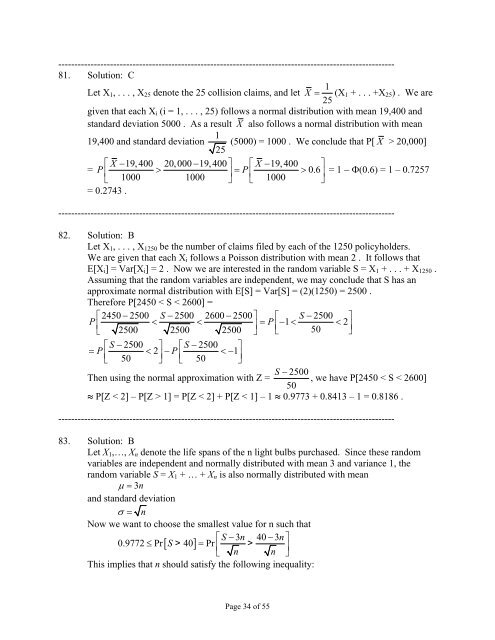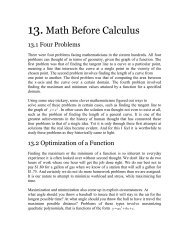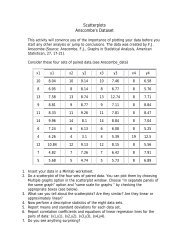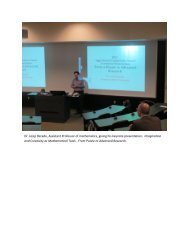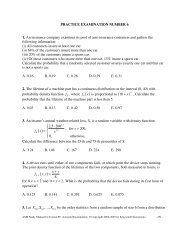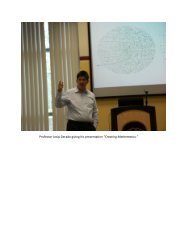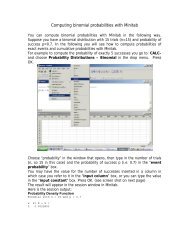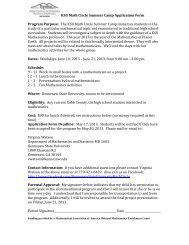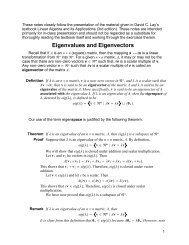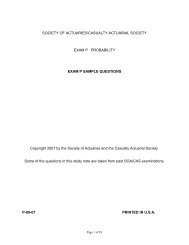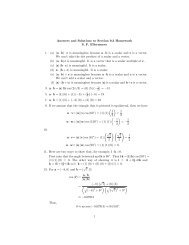EXAM P SAMPLE SOLUTIONS
EXAM P SAMPLE SOLUTIONS
EXAM P SAMPLE SOLUTIONS
Create successful ePaper yourself
Turn your PDF publications into a flip-book with our unique Google optimized e-Paper software.
--------------------------------------------------------------------------------------------------------<br />
81. Solution: C<br />
1<br />
Let X 1, . . . , X25<br />
denote the 25 collision claims, and let X = (X 1 + . . . +X25)<br />
. We are<br />
25<br />
given that each Xi (i = 1, . . . , 25) follows a normal distribution with mean 19,400 and<br />
standard deviation 5000 . As a result X also follows a normal distribution with mean<br />
19,400 and standard deviation 1<br />
(5000) = 1000 . We conclude that P[ X > 20,000]<br />
25<br />
⎡X −19,400 20,000 −19,400⎤ ⎡X<br />
−19,400<br />
⎤<br />
= P⎢ > = P<br />
0.6<br />
1000 1000<br />
⎥ ⎢ ><br />
⎣ ⎦ ⎣ 1000<br />
⎥ = 1 − Φ(0.6) = 1 – 0.7257<br />
⎦<br />
= 0.2743 .<br />
--------------------------------------------------------------------------------------------------------<br />
82. Solution: B<br />
Let X 1, . . . , X1250<br />
be the number of claims filed by each of the 1250 policyholders.<br />
We are given that each Xi follows a Poisson distribution with mean 2 . It follows that<br />
E[X i] = Var[X i] = 2 . Now we are interested in the random variable S = X 1 + . . . + X1250<br />
.<br />
Assuming that the random variables are independent, we may conclude that S has an<br />
approximate normal distribution with E[S] = Var[S] = (2)(1250) = 2500 .<br />
Therefore P[2450 < S < 2600] =<br />
⎡2450 −2500 S−2500 2600 −2500⎤ ⎡ S−2500<br />
⎤<br />
P⎢ < < ⎥ = P 1 2<br />
2500 2500 2500<br />
⎢<br />
− < <<br />
50 ⎥<br />
⎣ ⎦ ⎣ ⎦<br />
⎡S−2500 ⎤ ⎡S−2500 ⎤<br />
= P<br />
⎢<br />
< 2 − P 1] = P[Z < 2] + P[Z < 1] – 1 ≈ 0.9773 + 0.8413 – 1 = 0.8186 .<br />
--------------------------------------------------------------------------------------------------------<br />
83. Solution: B<br />
Let X1,…, Xn denote the life spans of the n light bulbs purchased. Since these random<br />
variables are independent and normally distributed with mean 3 and variance 1, the<br />
random variable S = X 1 + … + Xn is also normally distributed with mean<br />
μ = 3n<br />
and standard deviation<br />
σ = n<br />
Now we want to choose the smallest value for n such that<br />
⎡ S−3n 40−3n⎤ 0.9772 ≤ Pr[ S > 40] = Pr ⎢ > ⎥<br />
⎣ n n ⎦<br />
This implies that n should satisfy the following inequality:<br />
Page 34 of 55


